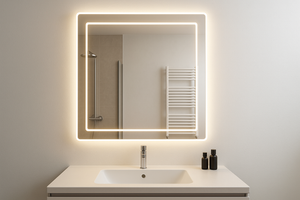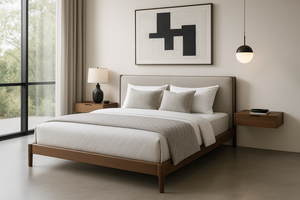Electric Projector Screens The Ultimate Guide for Home and Office Use

Electric projector screens are transforming viewing experiences. They offer convenience and superior image quality, making them a popular choice for both home and office use.
But what exactly are electric projector screens? They are motorized screens that can be retracted or extended at the push of a button. This feature makes them a versatile option for various settings.
In home theaters, they provide a cinematic experience. They can be hidden when not in use, maintaining the aesthetics of your living space. For offices and educational institutions, they enhance presentations, making them more engaging and professional.
Choosing the right electric projector screen can be a daunting task. There are various factors to consider, such as screen size, aspect ratio, and the type of screen material.
This guide aims to simplify that process. It provides comprehensive information on electric projector screens, helping you make an informed decision. Whether you're a home theater enthusiast or a business professional, this guide is for you.
Shop our range of Electric Projector Screens today!
Understanding Electric Projector Screens
Electric projector screens provide an innovative way to display images and videos. Unlike traditional screens, they operate with a motorized mechanism that enhances convenience.
These screens retract and deploy seamlessly. At the core of their operation is a motor, often controlled remotely. This technology allows users to adjust the screen with ease and precision.
There are several types of motorised projector screens available. Each type caters to different needs and settings. Here's a brief rundown of the most common types:
- Wall-mounted screens: Fixed to a wall, these are ideal for dedicated spaces.
- In-ceiling screens: Concealed within the ceiling, they offer a sleek, hidden look.
- Floor-rising screens: Suitable for spaces where wall installation isn't possible.
- Portable screens: Lightweight and easy to move, perfect for on-the-go presentations.
Choosing the right type is crucial. It depends on the environment and specific usage requirements. A home theater might benefit from an in-ceiling screen, while a business might find a wall-mounted or portable screen more suitable.
Understanding these screens' workings and variations is essential. It ensures you select the best option for your viewing needs.
Benefits of Electric Projector Screens in Home Theaters
Electric projector screens elevate the home viewing experience dramatically. They offer stunning image quality that transforms any room into a private cinema.
The seamless operation of a motorized screen adds to the aesthetic appeal. Without manual handling such as in pull up projector screens, the setup stays clean and uncluttered. This feature keeps the focus on the movie, not the screen itself.
Another significant advantage lies in customization. Homeowners can choose screen sizes and aspect ratios that suit their specific space and viewing preferences.
Motorized screens also integrate well with existing decor. Whether it's a living room or a dedicated theater, their sleek design fits effortlessly. When retracted, they virtually disappear, preserving the room's aesthetics.
These screens are versatile. They adapt to various lighting conditions, ensuring excellent image quality at all times. Customization further extends to screen material options, allowing for personalized viewing experiences tailored to any home.
Advantages for Professional and Educational Settings
Electric projector screens bring a touch of professionalism to any setting. In business presentations, they enhance visual clarity, making slideshows more impactful. Clear and vivid visuals ensure that the audience remains engaged throughout sessions.
In educational environments, these screens facilitate effective teaching. Teachers can display lessons with exceptional detail and clarity, aiding student comprehension. This improves both attention and retention rates.
The convenience of motorized screens cannot be overstated. With a simple press of a button, the screen is ready to use, saving time and effort. This instant access is particularly useful in fast-paced professional and educational settings.
Efficiency is a key advantage of electric projector screens. They streamline the transition between different presentations or classes. This allows for a smoother flow of information, optimizing both teaching and business operations.
Moreover, their sophisticated design contributes to a professional atmosphere. The sleek appearance complements any conference room or classroom, adding a sense of modernity and organization. Overall, electric screens are an invaluable addition to any professional or educational environment.
Key Features to Consider
Choosing the right electric projector screen involves several important considerations. One of the first is the screen size. The size of the screen should complement the room dimensions for the best viewing experience. Equally important is the aspect ratio, which should match the content you plan to display. Different aspect ratios are better suited for movies or presentations, so choose accordingly.
Next, consider the screen material, which significantly impacts image quality. The material's gain, or the ability to reflect light, affects brightness and viewing clarity. A screen with higher gain enhances brightness, ideal for spaces with controlled lighting. Conversely, a lower gain may suit darker environments.
Viewing angle plays a crucial role in maintaining image quality for viewers sitting at various angles. A wider viewing angle ensures everyone, no matter where seated, sees a consistent, clear image. This is critical for larger rooms or audiences.
The choice between tensioned and non-tensioned screens is another vital aspect. Tensioned screens offer a flat, ripple-free surface, ensuring optimal image quality and longevity. Non-tensioned screens may develop wrinkles over time, which could affect the projected image.
Ambient light rejection (ALR) technology is essential for rooms with high light levels. ALR screens minimize the impact of ambient light, maintaining image brightness and contrast. This technology is especially beneficial in spaces where lighting cannot be easily controlled.
When evaluating these features, balance them with your specific needs. Consider how each aspect interacts with your environment and usage. Here's a quick checklist to guide your decision:
- Screen Size: Suitable for room dimensions
- Aspect Ratio: Compatible with your content
- Screen Material and Gain: Matches brightness needs
- Viewing Angle: Ensures image quality from all positions
- Tensioned vs. Non-Tensioned: Flatness versus potential wrinkles
- ALR Technology: Ideal for bright environments
Thoughtful consideration of these features will help you select an electric projector screen that meets your needs and enhances your viewing experience.
Installation and Maintenance
Installing an electric projector screen correctly is essential for optimal performance. Consider the environment before starting the installation process. For wall-mounted screens, ensure the wall can support the screen's weight. Secure mounting hardware is crucial for stability and safety.
Ceiling installations require checking the ceiling structure. You want to avoid complications if the ceiling cannot bear the weight properly. Use anchors and brackets designed specifically for ceiling installations for added security.
In-floor setups, assess the floor's capacity to accommodate the screen mechanism. These floor-rising models offer clean aesthetics but require careful spatial planning. Always follow the manufacturer's guidelines for installation to avoid voiding warranties.
Regular maintenance prolongs the screen's life. Dust the screen surface gently with a microfiber cloth to prevent scratches. Avoid harsh cleaning agents that can damage the screen material.
For the motorized components, periodic checks are advisable. This includes ensuring the motor functions smoothly, without unusual noises. Simple actions like these extend the projector screen's operational life and maintain its performance.
Electric Screen Technologies and Smart Home Integration
Electric projector screens have advanced motorized mechanisms. These mechanisms enable smooth, quiet operation, enhancing the viewing experience. Motors are designed for durability and efficiency, ensuring long-lasting performance.
Remote control options add a layer of convenience. You can control the screen’s position with a simple button press. Options range from basic remotes to advanced wall switches that integrate seamlessly with the setup.
The integration of smart home technology is gaining popularity. Electric screens can be incorporated into smart home systems. This allows users to control screens through voice commands or smartphone apps.
Automation takes convenience to another level. Imagine having your screen lower automatically when you turn on your projector. This synchronized operation with other home systems streamlines your setup.
Compatibility with platforms like Google Home or Amazon Alexa is a plus. This feature lets you include your screen in various home automation routines. As technology progresses, these integrations will become even more prevalent, offering users an effortless, sophisticated experience.
Safety and Energy Efficiency
Safety is a primary consideration for electric projector screens. Many models include automatic retraction if obstacles are detected. This prevents damage and ensures user safety at all times.
Energy efficiency is another key feature. Modern electric screens consume minimal power, focusing on sustainable operation. Look for Energy Star-rated models to further optimize energy use.
Some screens offer programmable settings. These settings help manage power usage more effectively. You can schedule screen activities, limiting active use to necessary times only.
Manufacturers also design screens with robust casings to protect internal mechanisms. This design choice not only improves durability but also contributes to safer, more reliable operation in various environments.
Choosing the Right Electric Projector Screen for You
Selecting an electric projector screen involves several important considerations. Begin by assessing your primary use case. Whether it's for home cinema or an office setting will influence the features you prioritize.
Screen size and aspect ratio are crucial aspects. A home theater might need a wider aspect ratio for cinematic content. In contrast, educational or professional settings may require standard sizes that fit presentation needs.
Another consideration is the viewing environment. For spaces with bright lighting, an ALR (ambient light rejection) screen can significantly improve visibility and image quality.
Next, consider screen material and gain. Different materials offer varying levels of image brightness and clarity. Some may enhance colors, while others provide a more neutral tone for better accuracy.
The installation environment is also vital. Some screens are designed for in-ceiling or wall-mounted setups, while others are portable with pull-up options. Choose the one that fits your space and flexibility needs.
Budget often plays a decisive role. Conduct a cost-benefit analysis considering initial costs and potential long-term savings. Higher quality screens can deliver better image quality and last longer, offering greater value over time.
Here's a quick checklist to help make your decision:
- Identify primary use (home or office)
- Choose appropriate screen size and aspect ratio
- Consider lighting conditions
- Evaluate screen material and gain
- Plan for installation type and location
Assessing all these factors will guide you towards an investment that enhances your viewing experience. Remember, the right screen can make all the difference.
Future Trends and Innovations
Electric projector screens are evolving with cutting-edge technology. One significant trend is the integration of smart home systems. As homes become smarter, screens that sync with other devices are growing in demand.
Another exciting innovation is the use of advanced screen materials. These materials enhance color fidelity and contrast, even in bright environments. Such advancements cater to both entertainment and professional needs.
Moreover, ultra-short-throw (UST) projector compatibility is gaining traction. This trend allows for large images from short distances, making setups more flexible and space-efficient.
Energy-efficient designs are also becoming commonplace. Screens that consume less power while maintaining excellent performance address both environmental concerns and cost efficiency. Expect these trends to shape the future of electric projector screens, offering more choices for consumers.
Conclusion: Making the Right Investment
Selecting the perfect electric projector screen is crucial for optimal viewing experiences. This guide highlights the features and benefits to consider. Whether for home theaters or professional settings, choosing wisely ensures satisfaction and longevity.
Remember to evaluate important factors like screen size, material, and motorized mechanisms. These elements influence both performance and user experience. High-quality screens deliver better images and last longer, justifying the investment.
Incorporating smart integration and energy efficiency can enhance convenience and reduce costs. Make informed choices to leverage these advancements and maximize your enjoyment or productivity.
Armed with this knowledge, you are better prepared to select the right screen for your needs. Consider what you've learned here before making a final decision.









